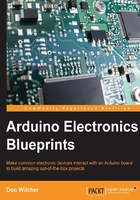
Chapter 2. Programmable DC Motor Controller with an LCD
A programmable logic controller (PLC) is an industrial computer that is used to operate various electronic and electromechanical devices that are wired to I/O wiring modules. The PLC receives signals from sensors, transducers, and electromechanical switches that are wired to its input wiring module and processes the electrical data by using a microcontroller. The embedded software that is stored in the microcontroller's memory can control external devices, such as electromechanical relays, motors (the AC and DC types), solenoids, and visual displays that are wired to its output wiring module. The PLC programmer programs the industrial computer by using a special programming language known as ladder logic. The PLC ladder logic is a graphical programming language that uses computer instruction symbols for automation and controls to operate robots, industrial machines, and conveyor systems.
The PLC, along with the ladder logic software, is very expensive. However, with its off-the-shelf electronic components, Arduino can be used as an alternate mini industrial controller for Maker type robotics and machine control projects. In this chapter, we will see how Arduino can operate as a mini PLC that is capable of controlling a small electric DC motor with a simple two-step programming procedure. Details regarding how one can interface a transistor DC motor with a discrete digital logic circuit to an Arduino and write the control cursor selection code will be provided as well. This chapter will also provide the build instructions for a programmable motor controller. The LCD will provide the programming directions that are needed to operate an electric motor. The parts that are required to build a programmable motor controller are shown in the next section.